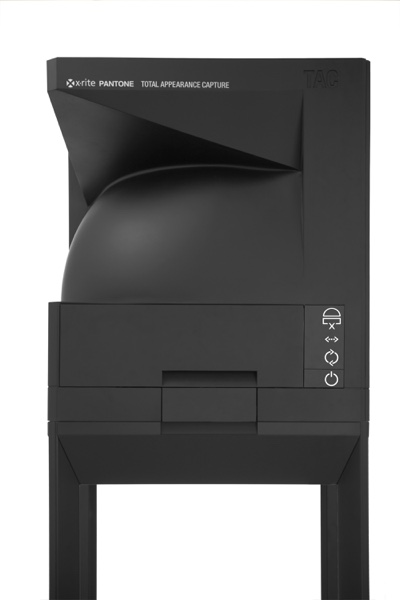Prepress
X-rie announces AxF

Friday 11. August 2017 - At SIGGRAPH 2017, X-Rite and NVIDIA will demonstrate how designers can simplify workflows by using physically accurate measured materials to simulate appearances for compelling, photorealistic 3D visualizations
X-Rite Incorporated, a global leader in color science and technology, and its subsidiary Pantone LLC, announced today that NVIDIA Iray natively supports the Appearance Exchange Format (AxF). Developed by X-Rite, AxF is a vendor-neutral format that enables the communication of all aspects of a physical materials appearance – color, texture, gloss, refraction, transparency, translucency, special effects (sparkles) and reflection properties – in a single, editable file to improve design virtualization. AxF gives designers and visual effects artists using NVIDIA Iray, access to physically accurate materials that simulate appearances to accelerate the overall design process and deliver the most compelling, photorealistic 3D visuals possible. X-Rite and NVIDIA will showcase the AxF integration in Iray at SIGGRAPH 2017, July 30 – August 3 in Los Angeles.
AxF is the foundational component of the X-Rite Total Appearance Capture (TAC) ecosystem, a solution that brings a new level of accuracy and efficiency to the capture, communication and presentation of physical materials in the virtual world. Traditionally, the capture and rendering of complex materials such as special effects paints, meshes and synthetic fabrics have been a time-consuming and manual process. TAC addresses this challenge with a new level of precision in material scanning coupled with an ability to share the resulting data, via AxF, across an expanding set of rendering tools such as Iray.
Moreover, Allegorithmic Substance Designer allows connecting AxF and NVIDIA Material Definition Language (MDL) definitions in a unified workflow, allowing any engine supporting MDL to incorporate scanned data definition from TAC ecosystem, or any MDL material to be mixed or ingested by AxF compliant workflow.
“The TAC ecosystem is the most accurate, fastest and easiest way to take real materials and migrate them into the digital world,” says Dr. Tobias Rausch, Portfolio Manager Total Appearance Capture at X-Rite. “NVIDIAs support of the AxF format means that Iray users can significantly streamline the overall creation process by starting with physically accurate files.”
NVIDIA MDL defines the materials properties for Iray cross-vendor rendering engines, enabling the quick exchange of materials between multiple software and rendering technologies. MDL supports popular material models such as those in AxF without additional changes in a renderers core shading code. Thus, Irays integration of AxF through the MDL technology combines measured materials with the fully programmable support for procedurally generated textures and functions with full GPU acceleration of MDL.
“AxF is the perfect companion to MDL for truly lifelike virtual experiences and imagery,” says Bob Pette, vice president of Professional Visualization at NVIDIA. “It slashes the time required to get photograph fidelity material into all render engines supporting MDL and fully aligns with the demanding photorealistic rendering quality required by our users.”
AxF is unique in its ability to compress raw scanned data from terabytes to megabytes, providing third-party software applications like Iray with efficient access to a full set of material appearance characteristics without compromising performance.
SIGGRAPH Presentation
Dr. Tobias Rausch, Portfolio Manager Total Appearance Capture at X-Rite, and Sébastien Deguy, CEO of Allegorithmic, will present at SIGGRAPH on Sunday, July 30 in Room 404AB at 2 pm. They will discuss how combining AxF, TAC7 scan data, MDL and Substance tools are changing the game for a full “scan-to-material” seamless workflow.
TAC Captures Physical Material Appearance at SIGGRAPH
SIGGRAPH 2017 attendees can see a demonstration of X-Rites award-winning Total Appearance Capture (TAC) ecosystem and the AxF integration with Iray at the X-Rite booth 1104. Attendees will see how AxF files can be used within Iray and applied to their renderings and animations.
The TAC ecosystem is comprised of the TAC7 scanner, PANTORA Material Hub desktop application, and Virtual Light Booth (VLB). Physical material samples are scanned using the TAC7 scanner, which captures appearance properties digitally to create AxF files that store appearance data. The files are stored, managed, viewed and edited in the PANTORA desktop application. The AxF files can be shared with Product Lifecycle Management (PLM), Computer-Aided Design (CAD), and state-of-the art rendering applications including Allegorithmic Substance Designer, AMD Radeon ProRender, Autodesk VRED Professional 2017, Lumiscaphe Patchwork 3D, Luxion KeyShot Next Limit Maxwell, and NVIDIA Iray.
The TAC Virtual Light Booth is the industrys first immersive 3D visualization environment for evaluating material appearance. It allows users to accurately and efficiently visualize and compare 3D digital material renderings side-by-side with physical samples. The VLB combines X-Rites SpectraLight QC professional light booth technology with a high-brightness, color-calibrated, LCD display; color management technology; and motion tracking sensors. This allows the VLB viewing environment to control parameters that influence the perception of appearance from illumination to contextual to observational factors. With the VLB, design teams can easily verify these conditions to see changes in material performance. This helps ensure consistency between digital prototypes and final physical products and empowers designers to make more informed material selection decisions reducing approval cycles and accelerating time to market.
